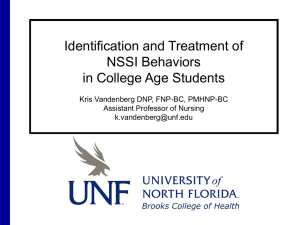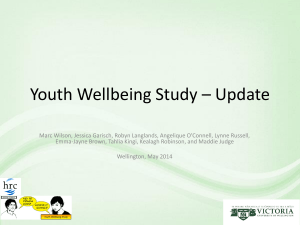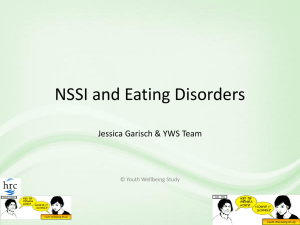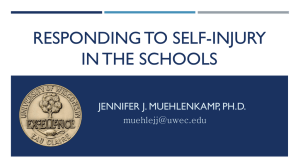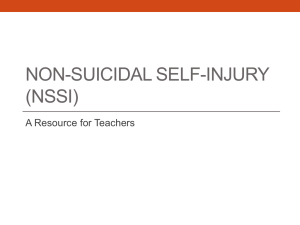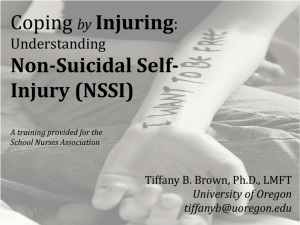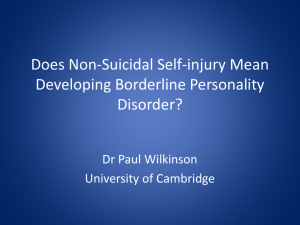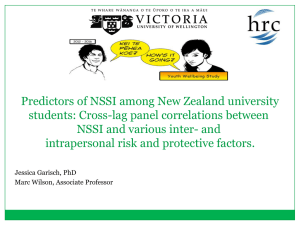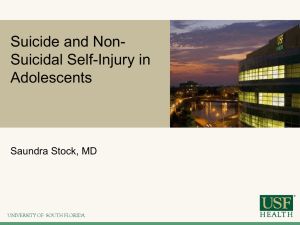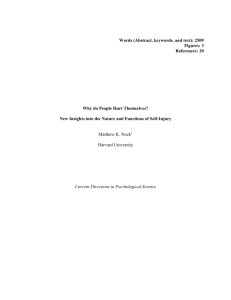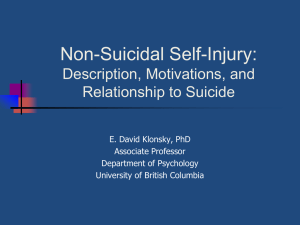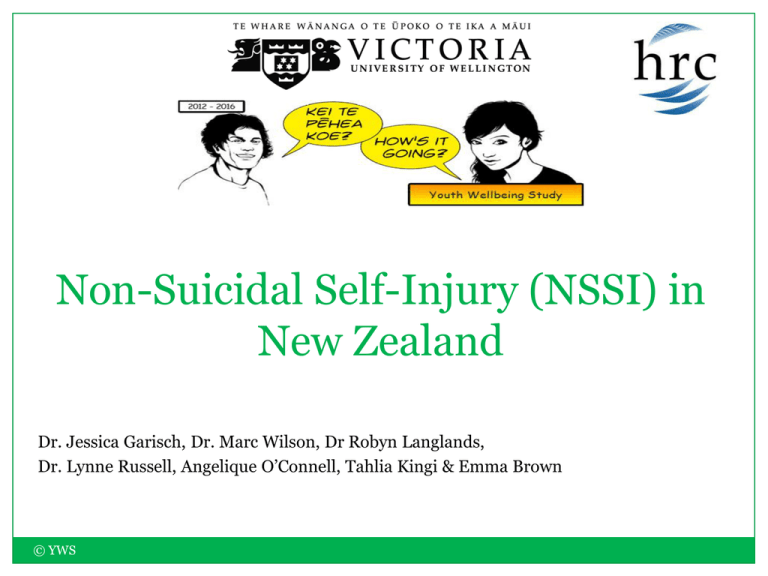
Non-Suicidal Self-Injury (NSSI) in
New Zealand
Dr. Jessica Garisch, Dr. Marc Wilson, Dr Robyn Langlands,
Dr. Lynne Russell, Angelique O’Connell, Tahlia Kingi & Emma Brown
© YWS
Background
What is non-suicidal self-injury (NSSI)
Deliberate destruction of body tissue
Not culturally appropriate
Without suicidal intent
Distinguishing between NSSI and suicide
Past research investigating ‘deliberate self-harm’ typically does not
disentangle suicidal and non-suicidal intent.
However NSSI is a potential suicide risk factor
©YWS
People may attempt to manage suicidal thoughts through self-injuring (Klonsky,
2007).
Repeated NSSI may desensitise people to the physical and psychological cues (e.g.,
pain, the sight of blood) that ordinarily inhibit engaging in suicidal behaviours
(Joiner, 2005).
Previous Research our team has been involved in...
Research on the functions of NSSI (Langlands, 2012; Wilson & Langlands,
2011)
NSSI predominantly represents attempts to avoid or escape from intense, negative
emotional experiences. Cognitive avoidance (e.g. escape from unwanted thoughts) is
also an important factor (based on an interview study with adults, N=24)
The emotional avoidance and regulatory functions are central reinforcement and
maintaining factors for NSSI (based on a survey study across New Zealand, N=198)
Negative intrapersonal experiences and avoidant coping styles were found to vary as a function of
NSSI history and recency (based on a survey study university students, N=408).
©YWS
Previous Research our team has been involved in...
Interviewing youth and guidance counsellors in the Wellington region
(Gilbertson & Wilson, 2008) : issue of ‘attention seeking’
‘Real’ self-injury is private but worthy of assistance, while ‘attention-seeking’
self-injury is public and unworthy
To seek help entails moving from one category (private, worthy) into the
other category (public, unworthy)
Social perception of NSSI hinders help-seeking and encourages secrecy?
©YWS
Previous Research our team has been involved in...
Research in secondary schools in the Wellington region (Garisch &
Wilson; 2010)
Longitudinal survey (over 1600 participants, aged 16-19)
Guidance counsellor interviews
NSSI not routinely talked about in school, considered “abnormal”, “taboo” “ew”
factor, dilemmas of whether to talk about it as fear of contagion.
Stereotypes study
©YWS
Prevalence lifetime hx ever NSSI: 49% by the time students leave school
NSSI associated w/ negative characteristics e.g. manipulative, attention seeking.
Continuing questions...
What factors are causal to the development and cessation of NSSI
What factors are protective
Are these factors variable by gender, ethnic background, age, etc.
How can we encourage help-seeking related to NSSI, given the stigma
and social barriers to disclosure?
What do schools, communities, whānau and young people need to
manage this behaviour effectively?
©YWS
Youth Wellbeing Study
Research into the development and cessation of NSSI among New
Zealand adolescents
Overall project includes
©YWS
Longitudinal Survey over five years (students complete survey 1+ times/yr)
Interviews and focus groups with pastoral care staff in intermediate and
secondary schools
Interviews and focus groups with young people aged 12-19 years
Interviews and focus groups with parents + whānau
Longitudinal survey: What was measured?
©YWS
Demographics
NSSI:
NSSI thoughts and behaviour measured by DSHI (Lundh et al. (2007))
Functions of NSSI (Inventory of Statements About Self-injury (ISAS; Klonsky et al.,
2009)
Intrapersonal factors
Emotion regulation (The Emotion Regulation Index for Children and Adolescents
(ERICA), MacDermott et al., 2010)
DASS anxiety and depression scales (DASS-21; Lovibond & Lovibond (1995))
Impulsivity (BIS-11; Patton et al., 1995)
Inventory of Parent and Peer attachment (Armsden & Greenberg , 1987).
Resilience (Resilience Scale for Adolescents (READ: Hjemdal et al., 2006)
AOD use (CRAFFT; see Knight et al., 2002)
Interpersonal functioning and social environment
Bullying (items taken from Youth 2000)
Abuse history (brief screening items; Thombs et al., 2007)
Preliminary results
5 schools; N= 362 (165 male, 189 female (8 missing))
12-14 years (mean 13.33)
Prevalence of NSSI
Screening Question: Sometimes people hurt themselves deliberately (i.e., on
purpose) to cause damage to their body but NOT to kill themselves (e.g. cut, burned,
scratched, or carved your skin, banged or hit yourself, or prevented wounds from
healing). Sometimes people have thoughts about hurting themselves on purpose, but do
not actually hurt themselves. Please indicate whether you have had thoughts about
hurting yourself on purpose (but not actually done this), have hurt yourself on purpose
(e.g. cut, burnt, scratched or carved your skin, etc.), or have never done this:
NO, I have never hurt myself on purpose
YES, I have hurt myself on purpose
I have thought about hurting myself on purpose
©YWS
78.15%
20.17%
1.68%
Prevalence of Types of Non-Suicidal Self-Injury
©YWS
Type of
NSSI
Not
thought
about
Thought
Done
about (not once
done)
Done a
few times
Done
many
times
Cutting
86.9
3.6
2.3
4.3
2.9
Scratched
90.7
1.8
2.0
4.1
1.4
Carving
92.5
1.6
2.5
1.8
1.6
Sticking sharp
objects
93.4
0.5
3.2
1.8
1.1
Prevent
wounds heal
93.4
1.6
2.9
1.6
0.5
Punch self
94.3
0.9
2.0
1.6
1.1
Bitten self
95.0
1.8
1.6
1.1
0.5
Burned
95.9
1.6
1.1
0.7
0.7
Rubbed glass
97.1
0.9
1.1
0.7
0.2
Sandpapered
98.4
0.5
0.7
0.5
0
Acid on skin
99.5
0.2
0.2
0
0
Bleach
99.5
0.2
0.2
0
0
Preliminary Results: Covariates
Construct
Internal
reliability
Emotion regulation
.81
-.36 ***
Self-esteem
.90
-.48***
Anxiety
.86
.54***
Depression
.91
.59***
Bullying (frequency)
.33***
Attachment to parents
.87
-.29**
Attachment to friends
.88
-.26*
Alcohol and Drug use
.64
.46***
Impulsivity
.80
.35***
Resilience
.95
.31***
Abuse history
.72
.59***
*p<.05, **p<.01, ***p<.001
©YWS
Correlation w/
NSSI
Sex differences in prevalence
T-test
Males
©YWS
No: 85.9%
Thought about self-injuring: 1.8%
Yes, had self-injured: 12.3%
Females
No: 70.6%
Thought about self-injuring: 1.6%
Yes, had self-injured: 27.8%
Contrary to previous findings with older adolescents in New Zealand, where
there was no significant overall lifetime difference in prevalence rates
(Garisch & Wilson, 2010).
Female participants (µ=2.79, s.d.=6.14) had significantly higher total
engagement in NSSI (thoughts and behaviours) than male participants
(µ=.99, s.d.= 3.45); t(2, 352)=-3.35***
Sex Difference continued...
Construct
Males: Correlation w/
NSSI
Females: Correlation
w/ NSSI
Emotion Regulation
-.16 (p=.08)
-.48***
Self-esteem
-.30***
-.57***
Depression
.42***
.66***
Anxiety
.28**
.64***
Parent attachment
-.24 (p=.16)
-.34*
Friends attachment
-.15 (p=.39)
-.35*
Abuse history
.38***
.62***
AOD
.39***
.49***
Impulsivity
.17 (p=.06)
.41***
Resilience
.20*
.40***
Frequency bullied
.32***
.35***
*p<.05, **p<.01, ***p<.001
©YWS
Pastoral care staff interviews + focus groups
4 Interviews and focus groups w/ pastoral care staff (N=7): Participants
attributed NSSI to a range of factors, particularly self-esteem, supports
available to them, and emotional difficulties:
“often the cutting..they have a self-image that is either unrealistic or unnecessarily
negative...I’m useless...I’m not good enough”
“Nice young girl who’ve been bought up to be polite, caring, empathetic, and looks
after others but tends to neglect her own needs...high standards of behaviour in the
household...anger is not allowed, so it’s suppressed, so they cut...they’ve got to let it
out somewhere, so this is how they do it”
“they do not have an emotional attachment that is functioning well enough for
them ...”
“...He would get really angry and then cut himself....sort of help bring him
down...”
©YWS
Pastoral care staff interviews + focus groups
Social context in schools
Not clearly distinguished from suicidal behaviour
Stereotypes e.g. “Attention seeking”, “Emo”, “drama queens”
Not typically talked about among staff
“but it’s very quickly shoved back in the wardrobe....the staff, it’s like a hot potato...the
minute they see anything like that ...they don’t wanna know...it’s straight over to us...I
think from their point of view they link it very closely with suicide...there’s very little
understanding amongst staff of why people may self-harm...for them it’s scary.”
“some education is required around the reasons why people do these things...how to
handle disclosure...how to handle it themselves...some of them get quite emotionally
upset and take that home with them...they worry...so some of them avoid going down that
path in the first place because they don’t want to go there at all”
“I think it would come as a shock to them how common it is”
©YWS
Summary
NSSI serves to regulate emotions (and cognitions), and through this is a
reinforcing behaviour for some people.
There is negative stigma of NSSI as ‘attention seeking’, manipulative, drama,
etc., which may lead people to continue this behaviour secretly rather than be
labelled.
Approximately 1 in 5 young people may have engaged in NSSI by their first year
in secondary school (and up to 1 in 2 by completion of secondary school).
There are significant sex differences in the correlates of NSSI. Risk and
protective factors are likely to differ by demographic factors.
School pastoral care staff have a broad view of NSSI and it’s complexity, but
show concern for the general knowledge of NSSI held among staff. Education
and training would be beneficial for school staff e.g. prevalence and functions.
Want to keep track of outcomes and resource development?
http://www.victoria.ac.nz/psyc/research/youth-and-wellbeing-study
©YWS
Acknowledgements
Health Research Council of New Zealand
Participating schools and pastoral care staff
©YWS

